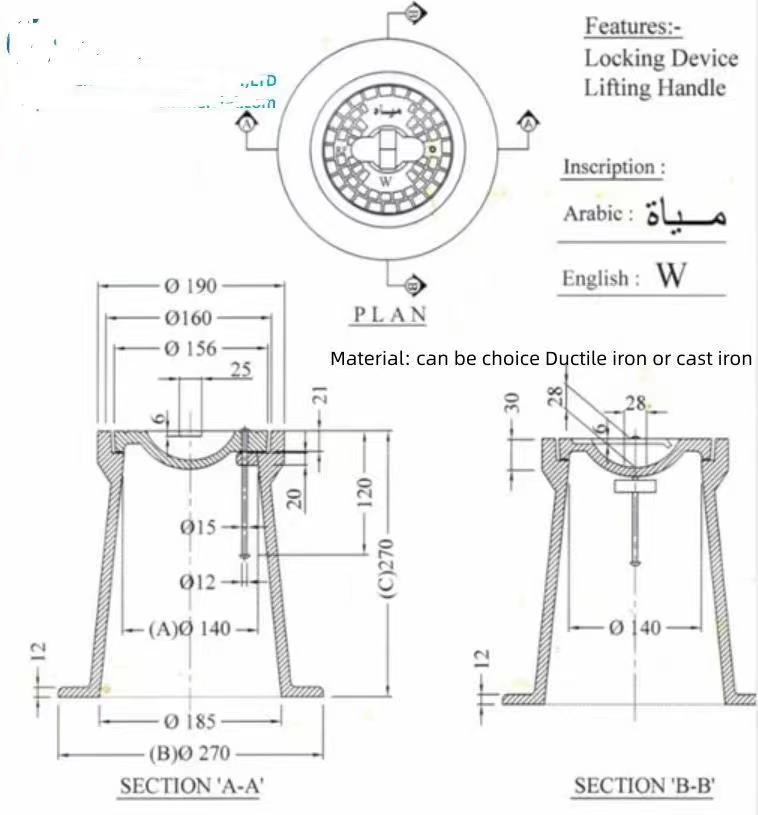inline butterfly valve
Understanding Inline Butterfly Valves A Comprehensive Overview
Inline butterfly valves are essential components in various industrial applications, particularly in systems that involve the control of fluid flow. These valves utilize a simple yet effective mechanism to regulate the passage of liquids or gases, making them a popular choice across multiple sectors, including water treatment, chemical processing, and HVAC systems.
What is an Inline Butterfly Valve?
An inline butterfly valve consists of a circular disc or plate mounted on a rotating shaft. The disc is positioned in the middle of the pipe, and when the valve is opened, the disc rotates a quarter-turn to allow fluid to flow freely. When the valve is closed, the disc aligns perpendicular to the flow direction, effectively blocking it. This design is both compact and efficient, allowing for quick operation and minimal pressure drop across the valve.
Key Features and Benefits
1. Compact Design Inline butterfly valves are generally more compact than other types of valves such as gate or globe valves. Their streamlined design makes them perfect for applications with space constraints.
2. Quick Operation The quarter-turn action of the butterfly valve allows for rapid opening and closing. This feature is particularly advantageous in emergency situations where a quick shut-off is crucial.
3. Minimal Pressure Loss Due to their design, inline butterfly valves impart very little resistance to flow, resulting in negligible pressure loss. This efficiency can lead to energy savings in systems where pressure management is critical.
4. Versatile Applications These valves can be used in various applications, including water supply systems, wastewater treatment plants, and chemical processing setups. Their ability to handle diverse media – from gases to corrosive liquids – makes them adaptable.
5. Low Maintenance Inline butterfly valves require relatively low maintenance compared to other valve types. Their simple design and few moving parts contribute to an increased lifespan and reduced operational costs.
Materials Used
The materials selected for inline butterfly valves can vary widely depending on the specific application and the media being transported. Common materials include
inline butterfly valve

- Cast Iron Often used for water and wastewater applications due to its durability and cost-effectiveness. - Stainless Steel Ideal for chemical processing and food-grade applications due to its corrosion resistance. - Plastic Generally used in low-pressure applications, especially in corrosive environments where metals may suffer from degradation.
Types of Inline Butterfly Valves
Inline butterfly valves are available in various types, designed to cater to specific needs
1. Wafer Butterfly Valves These are installed between two flange connections and don’t have their own flanges. They are lightweight and easy to install, making them common in industries where space is limited.
2. Lug Butterfly Valves Featuring threaded lugs that allow for installation without the need for full flange bolting, these valves are ideal for systems that must be serviced without needing to drain the pipeline.
3. Double-Flange Butterfly Valves These valves have flanges on both sides and are typically used in larger pipelines. They allow for easy installation and removal.
Installation and Maintenance
Proper installation of inline butterfly valves is critical to their performance. It is essential to follow manufacturer guidelines to ensure that the valve is positioned correctly and that any necessary gaskets or seals are in place. Regular maintenance can help in identifying wear and tear, ensuring that the valve operates reliably over time.
Checking for leaks, monitoring the operation of the actuator, and lubricating the mechanical parts periodically can enhance performance and longevity.
Conclusion
In conclusion, inline butterfly valves play a pivotal role in modern industrial applications. Their efficient design, quick operation, and reliability make them a preferred choice for many engineers and facility managers. As industries continue to evolve, the role of these valves in ensuring the smooth and efficient transport of fluids will only grow, solidifying their importance in engineering and operations. As you consider options for fluid control in your systems, understanding the capabilities and advantages of inline butterfly valves can lead to enhanced operational efficiency and safety in your processes.
-
The Smarter Choice for Pedestrian AreasNewsJun.30,2025
-
The Gold Standard in Round Drain CoversNewsJun.30,2025
-
The Gold Standard in Manhole Cover SystemsNewsJun.30,2025
-
Superior Drainage Solutions with Premium Gully GratesNewsJun.30,2025
-
Superior Drainage Solutions for Global InfrastructureNewsJun.30,2025
-
Square Manhole Solutions for Modern InfrastructureNewsJun.30,2025
-
Premium Manhole Covers for Modern InfrastructureNewsJun.30,2025
